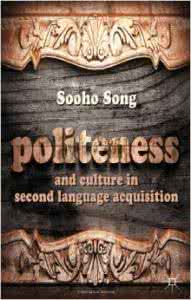1 Introduction
It is generally recognized that the great works of Robin T. Lakoff, Geoffrey N. Leech, and Penelope Brown and Stephen C. Levinson, launched in the 1970s, had greatly contributed to the studies of politeness theory. This shows that more and more people have realized the need to carry out research on this theory. Politeness is a prevalent phenomenon in human communication. Human speech and human behavior are always guided by the principles of politeness in our daily life. A polite person knows how to speak appropriately and how to behave appropriately. In the process of a person’s socialization, he or she learns how to act properly according to social expectations of politeness norms. Politeness can be expressed in two different ways: verbally and non-verbally. What the pragmatics theorists are concerned with is verbal politeness.
Brown and Levinson’s politeness theory has been one of the most influential theories in the pragmatics field since it was put forward in 1978. Their framework essentially is based on the premise of the Gricean formulations of conversational maxims and implicatures as an appropriate and correct analytic model, thereby assuming that the essence of utterance is based on a rational and efficient foundation so that a maximal exchange of information can be achieved. Nevertheless, we can more often than not find in spoken exchanges that everyday linguistic behavior deviates from Grice’s proposals. Brown and Levinson (1987) believe that such deviations from model situations are often driven by a motivation of politeness, which can give a seemingly rational account of the speaker’s obvious inefficiency and irrationality of linguistic behavior. They thus put forward the theory of politeness that guides any given speaker’s language use in real-life discourse. Admittedly, this theory is a great leap in the explanation of human interaction. However, some drawbacks can be found in Brown and Levinson’s politeness theory. The paper starts with the foundation of Brown and Levinson’s politeness theory — the concept of face, then has a further discussion of positive face and negative face, the regressive strategies for doing the FTAs and the formula for calculating the weightiness of an FTA, simultaneously points out the drawbacks of each of the aspects respectively, and finally arrives at the conclusion that when we have an exploration of politeness from a pragmatic perspective, social and cultural factors should not be treated lightly, not to mention be neglected.
2 The Concept of Face
Brown and Levinson’s universalistic formulations of politeness theory are problematic in some aspects. Face is the key notion in this theory. One of the main goals in social interaction is to maintain and even to enhance face during conversation. The concept first was introduced by the Chinese anthropologist Hu in 1944, though the term had been used in English for at least several centuries before that. The American sociologist Erving Goffman based much of his work on interpersonal relationship on the concept of face (Scollon, 2000: 34). Goffman defines face as “the
positive social value a person effectively claims for himself by the line others assume he has taken during a particular contact” (1967:5). He believes that though face itself, the phenomenon, is inherently attributable to individuals, its configuration is in fact not inherent and can only be bestowed on a person by others in interaction. In other words, its precise configuration is not a private property inherent in individuals, but a public image that individuals have to earn from society. Though Brown and Levinson claim that their concept of face is partially derived from Goffman’s, there is a great distinction between them. According to Brown and Levinson (1987:61), face is “the public self-image that every member wants to claim for himself”. Seen in this light, Brown and Levinson’s face is an individualistic, self-oriented image. Such a self-oriented characterization of face, which may very well underlie Western interaction, can be problematic in a non-Western context.
The Chinese concept of face consists of two distinct components: “面子mianzi” and “脸lian”. “面子mianzi” refers to an individual’s desire to achieve public recognition of his/her reputation or prestige, while “脸lian” stands for respect of the group for the individual who can meet both social and an internalized standards of moral behavior. The main difference between the two is that basically, “面子mianzi” has to do with an individual’s dignity or prestige, whereas “脸lian” has to do with a recognition by community for an individual’s socially acceptable, moral behavior or judgment. Nevertheless, both components involve respectable and reputable images that one can claim for oneself from the community in which one interacts or to which one belongs. Put another way, they both revolve around recognition by others of one’s desire for social prestige or reputation. Seen in this light, Chinese face work can be thought of as involving an interactional orientation on the part of the individual speaker toward establishing connectedness to, and seeking interpersonal harmony with, one’s own community — an orientation that mianzi and lian encode and epitomize (Mao, 1994:459). These two aspects of Chinese face have little relevance to an individual’s need for unhindered freedom of action or attention. They are closely associated with the views of the community. Therefore, Chinese face emphasizes the communal-aspect, rather than the individual one.
Moreover, unlike Brown and Levinson’s framework that places special emphasis on speakers taking redressive measures to address hearer’s face wants, the dynamics of Chinese facework is positively reciprocal with both parties engaged in mutually shared orientation to negotiate, elevate, and attend to each other’s face (Zhang: 1995:85). This balance of face plays an important role in Chinese context because giving face to others at the same time helps one to earn the recognition of the group, thereby not only protecting but also enhancing one’s own face.
The increasing concerns about the culturally specific inapplicability of Brown and Levinson’s face theory have led to the suggestion that their face theory actually embodies needs that are typical of needs of English-speaking cultures, and therefore, if taken as the basis for a universal theory of politeness, it is likely to run the risk of ethnocentricity (Watts, Ide, & Ehlich, 1992). Furthermore, it has been proposed that as far as future comparative, empirical politeness research is concerned, a helpful starting assumption is to try to regard Brown and Levinson’s theory as one primarily
anchored within the Western cultural context (Janney & Arndt, 1993). Thus, we can see that Brown and Levinson’s face theory does not have the property of universality that they claimed.
3 Positive Face and Negative Face
Brown and Levinson (1987) believe that when the speaker comes into any conversation, he has two seemingly conflicting face wants: a negative face want, which is the desire to act unimpeded by other people; and a positive face want, which is the desire to be liked by others. They define negative face as the basic claim to territories, personal preserves, rights to non-distraction, i.e., to freedom of action and freedom from imposition. Obviously, not all cases of face and politeness can be explained in terms of a simple distinction between positive face and negative face, and many arguments based on such a clear-cut distinction may turn out to be problematic.
In the Chinese context, one is presumed not to be motivated by a desire for freedom (negative face), but instead to seek the respect of the group (面子mianzi). In other words, compared with negative face, Chinese 面子mianzi focuses not so much on freedom of action as on respect or prestige of the community.
Take Chinese non-acceptance for example. Since Brown and Levinson’s theory cannot really deal with Chinese politeness behavior, the question is how to explain such kind of utterances. One of the Chinese norms is to display modesty, i.e., a traditional value concept constituting being polite. It is clear that Chinese non-acceptance is the embodiment of the cultural norm of modesty. By rejecting the compliment given and humbling themselves, complimentees verbally demonstrate their knowledge of Chinese face, thereby achieving public acknowledgement of their reputation or prestige and maintaining their face. By doing so, they are able to give face to the complimenter, and this behavior is deemed to be polite. Put simply, since the value of modesty is prevalent in Chinese society, the Chinese complimenter feels that his/her face is enhanced as he/she recognizes that the complimentee has been polite to him/her. Nevertheless, an American probably feels rebuffed and may suffer some face damage in that honesty leads him/her to infer that his/her opinion is insignificant to the complimentee. In Chinese context, this type of response in fact is irrelevant to Brown and Levinson’s claimed negative politeness.
From the above example, we can see that Brown and Levinson’s distinction of positive face and negative face is not likely to be applied cross-linguistically and cross-culturally to the linguistic behaviour.

4 Comparison between Japanese Politeness Strategies and English Politeness Strategies
When people are involved in conversions, they individually consider certain variables “face”, and defined it as “the positive social value a person effectively
claims for himself by the line others assume he has taken during a particular contact”. In 1978, Brown and levinson, using Goffman’s definition of “face” as a starting point, proposed a comprehensive and, according to Brown and Levinson, universal theory of politeness. Since that time, researchers have been working to refine the definition of face and adapt this politeness theory, in order to decide whether or not the definition is universal.
In discussing how people from different cultures would implement their politeness strategy, they introduce the “ethos”, defined as “the affective quality of interaction characteristic of members of a society.” Since different cultures embody differences in ethos, certain cultures will have a tendency towards one or another of the five main politeness strategies. For example, they claim that the U.S. is a positive-politeness culture because the level of weightness of any given FAT remains relatively low, while Japan is a negative-politeness culture because the people tend to be more “standoffish”. Charaterizing a culture as a positive-politeness or negative-politeness culture does not mean that that strategy is the only strategy used, but only that it is more prevalent within that culture. Thus, while claiming that their theory is universal, Brown and Levinsion have allowed for the differences in strategy selection that may arise across cultures.
5 Conclusion
When it comes to politeness, the issue of universality versus culture-specificity has been one of the hotly-debated points in the pragmatics field. Some theorists believe that the phenomenon of politeness is universal (Brown and Levinson, 1978, 1987; Leech, 1983). Moreover, they claim that the polite strategies are the same across cultures and languages. However, some scholars hold the view that speech acts vary across different languages and cultures. The above discussion indicates that the phenomenon of politeness is culture-bound and that cross-cultural factors are the predominant ones which give rise to the drawbacks of Brown and Levinson’s politeness theory. Their concept of face cannot be applied to speech acts in the Eastern cultures, including Chinese culture. Thus, we can draw a conclusion that social and cultural factors cannot be lightly treated when we do pragmatic research into politeness
References
1. Brown, Penelope, Stephen D. Levinson. 1987. Politeness: Some Universals in Language Usage [M]. Cambridge: Cambridge University Press.
2. Culpeper, Jonathan, D. Bousfield, A. Wichmann. 2003. Impoliteness Revisited: With Special Reference to Dynamic and Prosodic Aspects [J]. Journal of Pragmatics 35, 1545-1579.
3. Goffman, Erving. 1967. Interactional Ritual: Essays on Face-to-face Behavior
[M]. New York: Anchor books.
4. He, Zhaoxiong. 2000. A New Introduction to Pragmatics [M]. Shanghai: Shanghai Foreign Language & Education Press.
百度搜索“爱华网”,专业资料,生活学习,尽在爱华网
 爱华网
爱华网



